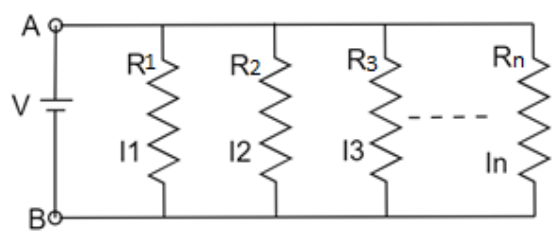
Draw the circuit diagram of \[n\] resistors connected in parallel and write the equation for equivalent resistance.
Answer
557.4k+ views
Hint: To find the equivalent resistance of any circuit, we need to find the quantity that relates the individual resistances to the circuit as a whole (in this case, the current flowing through the resistors). The advantage of a parallel combination is that each appliance operates to its maximum intensity.
Complete step by step solution:

The figure shows \[n\] resistances each of magnitude \[R\] connected in parallel across a source of voltage \[V\].
From ohm’s law, we know current flowing through a resistance is directly proportional to the voltage across it.
\[\Rightarrow V=IR\](where resistance \[R\] is the constant of proportionality)
Considering equivalent resistances one at a time, we can say that \[V={{I}_{1}}{{R}_{1}};V={{I}_{2}}{{R}_{2}};V={{I}_{3}}{{R}_{3}};V={{I}_{n}}{{R}_{n}}\] (since potential across all resistances in parallel combination is the same)
Considering the circuit as a whole, \[V=I{{\operatorname{R}}_{eq}}\]
Now, since the current originating from the voltage sources gets distributed among the resistances, we can say that
\[I={{I}_{1}}+{{I}_{2}}+{{I}_{3}}+--+{{I}_{n}}\]
For resistances connected in parallel across a source, we can say that the equivalent resistance expression will be
\[\dfrac{V}{{{\operatorname{R}}_{eq}}}=\dfrac{V}{{{\operatorname{R}}_{1}}}+\dfrac{V}{{{\operatorname{R}}_{2}}}+\dfrac{V}{{{\operatorname{R}}_{3}}}+--+\dfrac{V}{{{\operatorname{R}}_{n}}}\]
Further simplifying this expression, we can say that
\[\dfrac{1}{{{\operatorname{R}}_{eq}}}=\dfrac{1}{{{\operatorname{R}}_{1}}}+\dfrac{1}{{{\operatorname{R}}_{2}}}+\dfrac{1}{{{\operatorname{R}}_{3}}}+--+\dfrac{1}{{{\operatorname{R}}_{n}}}---equation(1)\]
If the resistances were of equal values, that is \[{{R}_{1}}={{R}_{2}}={{R}_{3}}={{R}_{n}}=R\] , we can write the expression for equivalent resistance as
\[\dfrac{V}{{{\operatorname{R}}_{eq}}}=\dfrac{V}{\operatorname{R}}+\dfrac{V}{\operatorname{R}}+\dfrac{V}{\operatorname{R}}+--+\dfrac{V}{\operatorname{R}}\]
\[\begin{align}
& \Rightarrow \dfrac{V}{{{\operatorname{R}}_{eq}}}=\dfrac{nV}{R} \\
& \Rightarrow {{\operatorname{R}}_{eq}}=\dfrac{R}{n} \\
\end{align}\]
This is the required equivalent resistance for \[n\] resistances each of magnitude \[R\] connected in parallel across a source of voltage \[V\].
Hence, the general equation for resistances connected in parallel is
\[\dfrac{1}{{{\operatorname{R}}_{eq}}}=\dfrac{1}{{{\operatorname{R}}_{1}}}+\dfrac{1}{{{\operatorname{R}}_{2}}}+\dfrac{1}{{{\operatorname{R}}_{3}}}+--+\dfrac{1}{{{\operatorname{R}}_{n}}}\]
Note: The resistance decreases as more components are added because current finds more paths to flow through, hence more current flows from the source than would flow for any of them individually. We can also be given a question asking to find the equivalent resistance for series combination. In that case, the voltage is the physical quantity which relates the individual resistances to the circuit as a whole.
Complete step by step solution:

The figure shows \[n\] resistances each of magnitude \[R\] connected in parallel across a source of voltage \[V\].
From ohm’s law, we know current flowing through a resistance is directly proportional to the voltage across it.
\[\Rightarrow V=IR\](where resistance \[R\] is the constant of proportionality)
Considering equivalent resistances one at a time, we can say that \[V={{I}_{1}}{{R}_{1}};V={{I}_{2}}{{R}_{2}};V={{I}_{3}}{{R}_{3}};V={{I}_{n}}{{R}_{n}}\] (since potential across all resistances in parallel combination is the same)
Considering the circuit as a whole, \[V=I{{\operatorname{R}}_{eq}}\]
Now, since the current originating from the voltage sources gets distributed among the resistances, we can say that
\[I={{I}_{1}}+{{I}_{2}}+{{I}_{3}}+--+{{I}_{n}}\]
For resistances connected in parallel across a source, we can say that the equivalent resistance expression will be
\[\dfrac{V}{{{\operatorname{R}}_{eq}}}=\dfrac{V}{{{\operatorname{R}}_{1}}}+\dfrac{V}{{{\operatorname{R}}_{2}}}+\dfrac{V}{{{\operatorname{R}}_{3}}}+--+\dfrac{V}{{{\operatorname{R}}_{n}}}\]
Further simplifying this expression, we can say that
\[\dfrac{1}{{{\operatorname{R}}_{eq}}}=\dfrac{1}{{{\operatorname{R}}_{1}}}+\dfrac{1}{{{\operatorname{R}}_{2}}}+\dfrac{1}{{{\operatorname{R}}_{3}}}+--+\dfrac{1}{{{\operatorname{R}}_{n}}}---equation(1)\]
If the resistances were of equal values, that is \[{{R}_{1}}={{R}_{2}}={{R}_{3}}={{R}_{n}}=R\] , we can write the expression for equivalent resistance as
\[\dfrac{V}{{{\operatorname{R}}_{eq}}}=\dfrac{V}{\operatorname{R}}+\dfrac{V}{\operatorname{R}}+\dfrac{V}{\operatorname{R}}+--+\dfrac{V}{\operatorname{R}}\]
\[\begin{align}
& \Rightarrow \dfrac{V}{{{\operatorname{R}}_{eq}}}=\dfrac{nV}{R} \\
& \Rightarrow {{\operatorname{R}}_{eq}}=\dfrac{R}{n} \\
\end{align}\]
This is the required equivalent resistance for \[n\] resistances each of magnitude \[R\] connected in parallel across a source of voltage \[V\].
Hence, the general equation for resistances connected in parallel is
\[\dfrac{1}{{{\operatorname{R}}_{eq}}}=\dfrac{1}{{{\operatorname{R}}_{1}}}+\dfrac{1}{{{\operatorname{R}}_{2}}}+\dfrac{1}{{{\operatorname{R}}_{3}}}+--+\dfrac{1}{{{\operatorname{R}}_{n}}}\]
Note: The resistance decreases as more components are added because current finds more paths to flow through, hence more current flows from the source than would flow for any of them individually. We can also be given a question asking to find the equivalent resistance for series combination. In that case, the voltage is the physical quantity which relates the individual resistances to the circuit as a whole.
Recently Updated Pages
A man running at a speed 5 ms is viewed in the side class 12 physics CBSE

The number of solutions in x in 02pi for which sqrt class 12 maths CBSE

State and explain Hardy Weinbergs Principle class 12 biology CBSE

Write any two methods of preparation of phenol Give class 12 chemistry CBSE

Which of the following statements is wrong a Amnion class 12 biology CBSE

Differentiate between action potential and resting class 12 biology CBSE

Trending doubts
What are the major means of transport Explain each class 12 social science CBSE

Which are the Top 10 Largest Countries of the World?

Draw a labelled sketch of the human eye class 12 physics CBSE

How much time does it take to bleed after eating p class 12 biology CBSE

Explain sex determination in humans with line diag class 12 biology CBSE

Explain sex determination in humans with the help of class 12 biology CBSE




